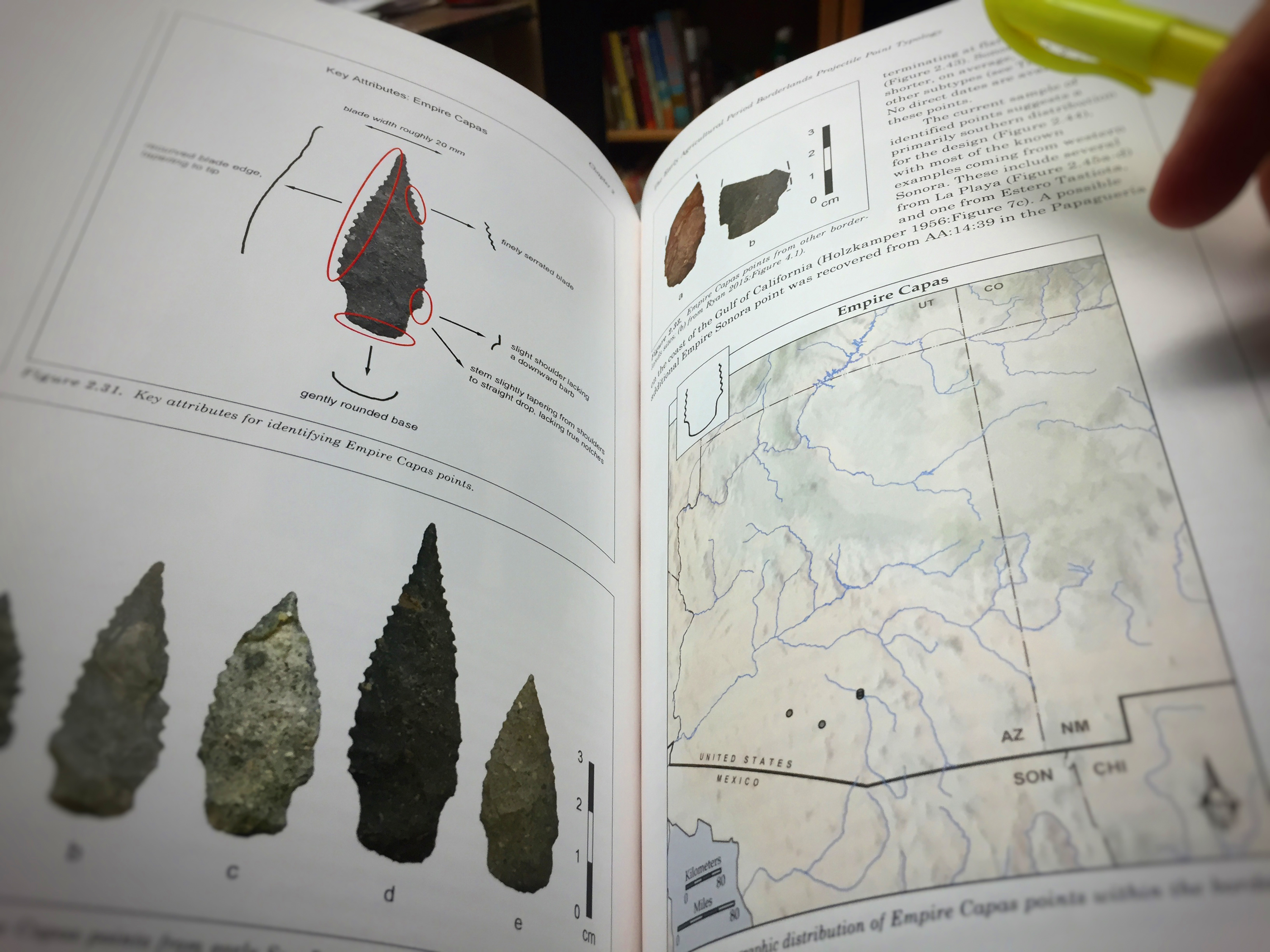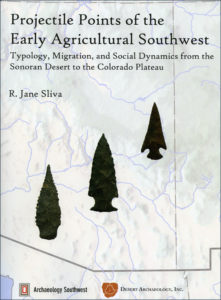
We Wrote the Book on That: Featured Works by Desert Archaeology Authors
R. J. Sliva takes you on a tour of the Desert Archaeology authors bookshelf.
Do you remember being a kid and getting so engrossed in what you were doing—reading a book, building a Lego tower, setting up elaborate dioramas with plastic dinosaurs—that you completely lost track of time and looked up after what you thought was maybe 15 minutes, only to find that several hours had passed? At Desert Archaeology, we know the feeling—except that we are adults and are looking up to realize that, despite having started at the company just last week, we swear, we’ve actually built careers spanning twenty years or more.
The decades have flown by because we aren’t doing the same thing every day. Each new project, each new collection of artifacts, each new unexplored area, presents an opportunity to fine-tune our approach or innovate new methods altogether. Ever-increasing precision in data collection and new perspectives on the archaeological record, backed by our ever-growing database, means we are able to constantly challenge old assumptions and investigate new questions, even in a time and place you might think has been thoroughly documented. Desert’s senior project directors and artifact analysts average 22 years with the company—an immersive experience in Southwestern archaeology that gives us a deep familiarity with the peoples and technologies of the past and the ability to fit things together in new ways.
Ultimately, time has flown thanks to the truth contained in a tagline on the front page of this website: The past is our passion. This isn’t just a 9-to-5 job for us. Long days at the office morph into evenings spent talking about archaeology with colleagues over a beer. We ponder the odd pattern that cropped up during yesterday’s data analysis over this morning’s breakfast. We outline reports in our heads while we walk the dog, testing this assumption and that phrasing, mentally crossing things out and rewriting until the logic and words fall into place and we urge the dog home so we can write it all down.
Over the years, our staff members have distilled that experience, expertise, and drive to write into books on different aspects of Southwestern artifact analysis. These works bring together the observations and expertise honed over ten, fifteen, twenty years, originally explored in our compliance reports, into stand-alone works that we can share with both professional colleagues and students venturing into the field for the first time. To that end, today we feature three books written by our staff members: one dealing with the analysis of an entire class of artifacts (ground stone), one with a specific artifact type (projectile points), and one with a specific technique (ceramic petrography).
 Ground Stone Analysis: A Technological Approach, by Jenny Adams, has become the standard reference in the field of ground stone. Ground stone artifacts include all stone items that are altered by, or used to alter other items through, abrasion, pecking, or polishing—including familiar artifacts such as manos and metates, and mortars and pestles—as well as artifacts shaped by abrasion or pecking, such as axes, pipes, and stone bowls. This work presents Adams’ analytical techniques and traces the different developmental trajectories of women’s and men’s ground stone technologies within the ancient cultural groups of the greater Southwest. The book is now in its second edition, incorporating many of the advances in scientific technology and developments in ethnographic and experimental research that have emerged since its original publication in 2002.
Ground Stone Analysis: A Technological Approach, by Jenny Adams, has become the standard reference in the field of ground stone. Ground stone artifacts include all stone items that are altered by, or used to alter other items through, abrasion, pecking, or polishing—including familiar artifacts such as manos and metates, and mortars and pestles—as well as artifacts shaped by abrasion or pecking, such as axes, pipes, and stone bowls. This work presents Adams’ analytical techniques and traces the different developmental trajectories of women’s and men’s ground stone technologies within the ancient cultural groups of the greater Southwest. The book is now in its second edition, incorporating many of the advances in scientific technology and developments in ethnographic and experimental research that have emerged since its original publication in 2002.
 In contrast to that broad-spectrum approach, Projectile Points of the Early Agricultural Southwest: Typology, Migration, and Social Dynamics from the Sonoran Desert to the Colorado Plateau, by Desert flaked stone analyst Jane Sliva, takes a deep dive into a single class of artifacts and a single time period in the Southwest. The book opens with a detailed point typology for the Early Agricultural period (c. 1200 B.C.-A.D. 50), including numerous photos and maps indicating geographical and temporal distributions. The second part of the book presents case studies from 20-plus years of Desert projects to examine how projectile point design informs on the social relationships, exchange networks, and population movement by early farmers and foragers across a wide swath of Arizona and northern Sonora.
In contrast to that broad-spectrum approach, Projectile Points of the Early Agricultural Southwest: Typology, Migration, and Social Dynamics from the Sonoran Desert to the Colorado Plateau, by Desert flaked stone analyst Jane Sliva, takes a deep dive into a single class of artifacts and a single time period in the Southwest. The book opens with a detailed point typology for the Early Agricultural period (c. 1200 B.C.-A.D. 50), including numerous photos and maps indicating geographical and temporal distributions. The second part of the book presents case studies from 20-plus years of Desert projects to examine how projectile point design informs on the social relationships, exchange networks, and population movement by early farmers and foragers across a wide swath of Arizona and northern Sonora.
 Integrative Approaches in Ceramic Petrography, edited by Desert petrographer Mary Ownby, was just released this month. The book compiles numerous case studies from the Southwest and other regions that highlight new developments within the field of ceramic petrography. It includes a chapter by Ownby, on a specific Classic period Hohokam ceramic ware produced in the Tucson Basin, and another by Desert senior ceramic analyst Jim Heidke, featuring his analysis of our collections from Honey Bee Village, a large Hohokam settlement in Oro Valley, Arizona. These chapters are fine examples of how the petrographic program developed at Desert Archaeology during the 1990s has expanded to incorporate new techniques and produce increasingly detailed insights on Hohokam pottery production and exchange, and the volume as a whole demonstrates the efficacy of petrographic techniques in varied geographic and temporal settings.
Integrative Approaches in Ceramic Petrography, edited by Desert petrographer Mary Ownby, was just released this month. The book compiles numerous case studies from the Southwest and other regions that highlight new developments within the field of ceramic petrography. It includes a chapter by Ownby, on a specific Classic period Hohokam ceramic ware produced in the Tucson Basin, and another by Desert senior ceramic analyst Jim Heidke, featuring his analysis of our collections from Honey Bee Village, a large Hohokam settlement in Oro Valley, Arizona. These chapters are fine examples of how the petrographic program developed at Desert Archaeology during the 1990s has expanded to incorporate new techniques and produce increasingly detailed insights on Hohokam pottery production and exchange, and the volume as a whole demonstrates the efficacy of petrographic techniques in varied geographic and temporal settings.
Our staff members value maximizing the research potential of our excavations, and their contributions to professional and academic journals, newsletters, and edited volumes go well beyond the three examples featured here. Just as science is cumulative, so it necessarily is collaborative. We hope that other researchers find our methods and theoretical orientations useful, and we also hope that as they apply them to their own research, they find ways to improve them, leading to more answers and tightening the science to the benefit of archaeology in the Southwest along the way. We hope that sharing with a broader audience advances an understanding of what archaeologists do and kindles in others the same passion for discovery that we bring to our work.
Resources
Be sure to browse our staff listings for links to individual Academia.edu pages, where you can find downloadable copies of selected manuscripts (free, no-hassle registration required).
Notable additional edited volumes featuring work by Desert Archaeology researchers:
Gendered Labor in Specialized Economies: Archaeological Perspectives on Female and Male Work, featuring a chapter by Jim Heidke.
Between Mimbres and Hohokam: Exploring the Archaeology and History of Southeastern Arizona and Southwestern New Mexico, edited by Henry Wallace.
Zuni Origins: Toward a New Synthesis of Southwestern Archaeology, edited by late DAI project director Dave Gregory, featuring chapters by Gregory, Mike Diehl, and geomorphologist Fred Nials.
Mimbres Society, featuring a chapter by Mike Diehl.

